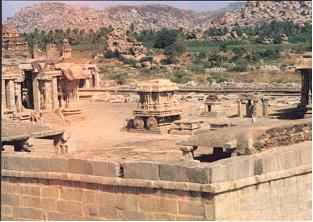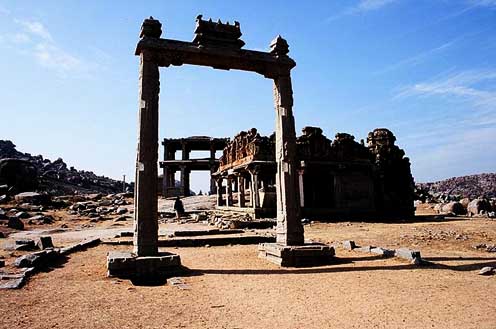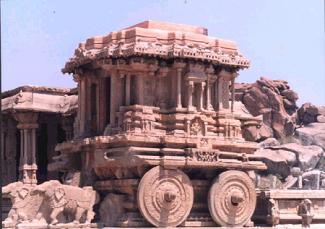Contribute
| South Asian Art - In Memory Of Prashant H. Fadia |
05/26/2008
IMPORTANT MONUMENTS AT HAMPI The plan of the typical Vijayanagara temple exhibits most of the characteristic features of South India. Most of the Vijayanagara temples at Hampi have a covered and pillared pradakshina-prakara round the garbhagriha and antarala. Generally the ardhamandapa has four ornate central pillars and two side porches with steps and surul yali balustrades. The mahamandapa is a highly ornate structure with many fine specimens of composite pillars. It is the most profusely embellished part of a Vijayanagara temple being rivalled only by the kalyana-mandapa. For civil architecture, stone was used for the base while various materials, like stone, wood, metal and brick, were employed in the superstructure. The arch, especially the wide four-centred type, was freely used in the construction. Elaborately ornate stucco decorations were largely used. The lotus and rampant yali motifs were most common. Ceilings were domed or vaulted. Often the superstructure above a palace-building had a number of diminishing tiers of kapotas (cornices) capped by a sikhara resembling a temple-vimana (e.g. the Lotus-Mahal at Hampi and the Gagan-Mahal at Penukonda). The buildings were originally painted and gilded.
1. Queens Bath 2. King's Palace - Enclosure 3.
The kalyana-mandapa is one of the highlights of the Vijayanagara style. This is usually an open pillared mandapa often with a raised platform in the centre, over which a pitha was placed for seating the deity and his consort during the annual kalyana (marriage) festival of the god. The sculptor's skill was fully lavished on these mandapas which contained elaborately carved and symmetrically-spaced compound pillars of various types. The ceilings were also carved. Originally these mandapas appear to have been painted and were often the most ornate of the structures in the temple-complexes.
The mantapas often have large elephant-balustrades flanking the entrance-steps. The pillars along the outer edge of the mandapa are of various composite types.The Vijayanagara gopuras at Hampi are in typical style, though they are of moderate size.
You may also access this article through our web-site http://www.lokvani.com/


